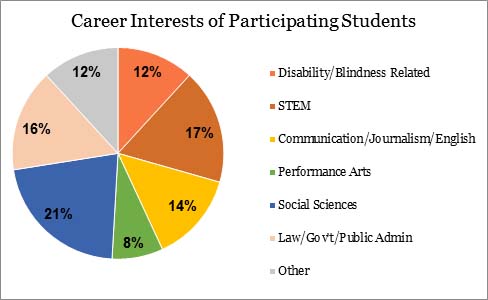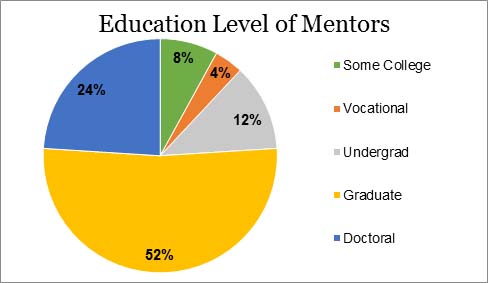Principal Investigator: Karla Antonelli, kantonelli@colled.msstate.edu
Graduating from college and getting a first job can be difficult for any student, but particularly so for students who are blind. These students often lack the work experience and professional skills of their peers who are not blind. Although students who are blind have the highest college attendance rates among students with disabilities, their rates of post-college employment are low.
In order to address this gap, this project matched students who are blind and preparing to graduate from college with mentors in their chosen career field who are also blind. Mentors can provide students with valuable insights and guide them as they make the transition from college to career. If the mentor is blind, they can also help their mentees navigate issues like transportation, assistive technology, and telling prospective employees about their visual impairment.
In this project, mentors and students worked together over the course of a year, with mentors providing their mentees experience, advice, and coaching. This project seeks to discover whether working closely with a mentor improves postgraduate employment outcomes for students who are legally blind. The hope is that, with the help of their mentors, participating students will not only have higher rates of employment, but will also be more satisfied with their jobs and have a stronger sense of self-efficacy.
Researchers from the National Research and Training Center (NRTC) on Blindness and Low Vision worked with consumer groups and institutions of higher education across the country to recruit mentors and mentees to participate in the program. In order to qualify, students had to be legally blind residents of the United States, graduating between April 2012 and December 2014. Participating mentors also had to be legally blind, and they were asked to provide their mentees with opportunities for job-shadowing and networking, as well as monthly face-to-face meetings.
Participating students were randomly assigned to either the intervention or comparison group and placed (based on their expected graduation date) into one of four program cohorts. In total, across the four cohorts, 51 students (25 comparison, 26 intervention) participated in the program, with 26 mentors also participating. Students in the comparison group received incentives to participate and information about careers. Students in the intervention group were matched with mentors. Both sets of students completed brief pre-tests to measure their job-seeking self-efficacy, assertiveness in job-seeking, and career optimism.

Mentor-mentee matches were made based on a number of factors, including location (ideally, the two should live less than an hour away) and career field. The goal was to match each student with a nearby mentor who was working in the student’s chosen career field. However, due to a limited mentor participant pool, some students were matched with “distance mentors,” who lived over an hour away.

In order to guide and structure the mentor/mentee relationship, the NRTC developed a mentoring manual for use by the mentor. The manual covered a wide range of topics, from technology and transportation to résumés and interviews. Mentors were encouraged to use the manual as a resource for conversations with their mentees.
After completing the program, students took post-tests to measure job-seeking self-efficacy, assertiveness in job-hunting, career adaptability, and employment outcomes (e.g., employment status, salary, benefits, job satisfaction, etc.). Students from the intervention group were also asked about their overall satisfaction with the program.
Students who worked with a mentor for one year significantly increased their assertiveness in job-hunting, whereas students in the comparison group did not. Mentees also showed trends of improvement in job-seeking self-efficacy and career adaptability.
Some students from both groups did not graduate as scheduled, extending their transition time to employment. In future employment mentoring programs, it will be important to consider helping students to accurately predict their graduation dates to make their job search go more smoothly.
Job placements were similar between the two groups at the post-test, but trends indicated that mentees may have had more efficient and independent job searches. NRTC researchers added a follow-up survey at least one year after students completed the study, to get updated information on their employment outcomes. Of those students responding, job placements were comparable at follow-up, but trends indicated that a higher percentage of mentees (16 of 21) than comparison students (8 of 15) were employed by that time.
Mentees and mentors reported overall high satisfaction with the program, and found value in the mentoring relationship. Mentees benefitted from working with mentors who were also blind and had experience navigating employment in their career field.

Project Outputs
- Employment Mentoring Manual is a resource for consumers and service providers who are interested in looking for a mentor and/or starting a mentoring program.
- Resource Sheet for Job Seekers provides some online resources for job seekers.
- Employment Mentoring for College Students with Visual Impairment - Online Short Course
Publications
- Kershaw, S. (2017). Career mentoring for college students: Insights from a program participant. Future Reflections, 36(3).
- O'Mally, J., & Steverson, A. (2017). Reflections on developing an employment mentoring program for college students who are blind. Journal of Visual Impairment & Blindness, 111(3), 271-276.
- O'Mally, J. & Antonelli, K. (2016). The effect of career mentoring on employment outcomes for college students who are legally blind. Journal of Visual Impairment and Blindness, 110(5), 295-307.
- Antonelli, K., O’Mally, J., & Steverson, A. (2018). Participant experiences in an employment mentoring program for college students with visual impairments. Journal of Visual Impairment and Blindness, 112(3), 274-286.
- Antonelli, K., Steverson, A., & O'Mally J. (2018). College graduates with visual impairments: A report on seeking and finding employment. Journal of Visual Impairment and Blindness, 112(1), 33-45.